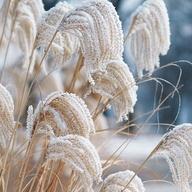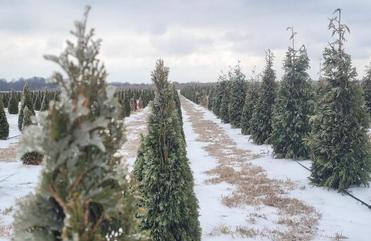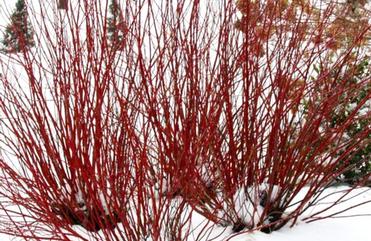Protect Your Plants From Winter Damage
Although it can seem like a quiet downtime for gardening, protecting your plants from winter injury can be critical to the longevity of your landscape. Sometimes even a small act that reduces cold or wind can mean the difference between the death or survival of a plant. Follow these strategies to fend off an impending frost or freeze event.

Protect Your Plants From Winter Damage
Although it can seem like a quiet downtime for gardening, protecting your plants from winter injury can be critical to the longevity of your landscape. Sometimes even a small act that reduces cold or wind can mean the difference between the death or survival of a plant. “Preparing Your Landscape for the Winter Season” lists the ways to prepare your property for winter. Here we suggest strategies to fend off an impending frost or freeze event.
Know your plants’ hardiness rating. Even if a plant falls within the temperature limits of your USDA cold-hardiness zone, take precautions for young and newly planted plants. Find your physical location in this interactive hardiness zone map here: https://planthardiness.ars.usda.gov. You can look up your plant’s hardiness rating in a number of creditable sources including Garden.org, https://garden.org, Gardenia.net, https://www.gardenia.net and the Missouri Botanical Garden’s Plant Finder, http://www.missouribotanicalgarden.org/plantfinder/plantfindersearch.aspx. Remember to save your plant tags so you know exactly what you have. It is wise to choose plant material that is hardy in the zone below yours, as an extra precaution against an abnormally cold winter. For containerized plants, use plant material that is suited to a couple of hardiness zones colder than yours. Plants native to your region are a good bet against cold damage.
Refer to “Frost Vs. Freeze” to determine when protection may be necessary. It's worthwhile to repeat here that protection is especially important if an advective freeze is on the way early in the season when plants haven’t had a chance to harden to the cold yet.
Water in the morning the day before a predicted frost or freeze. This gives plants time to absorb water (if the ground isn’t already frozen) to protect against desiccation. Also, well-watered soil absorbs more heat which will be released into the air at night to increase the temperature around the plant.
Use frost cloths. Frost cloths are not just for lengthening the vegetable growing season. These winter covers can provide an extra zone or more of warmth and protection from frost and very cold temperatures for landscape plants. They also prevent physical damage and desiccation from wind.
Frost cloths/row covers are sold under several different names (Reemay, Agribon, Gro-Guard, Typar, Agronet, Agryl, Harvest Guard, Agfiber, etc.), and are made in a range of weights or grades that have varying degrees of frost protection and light transmission. Reemay, one of the original brands, is a spun-bonded polyester fabric. It is strong and durable but tends to be abrasive, somewhat costly and susceptible to mildew. Polyethylene covers are clear or pigmented polyethylene plastic installed over support hoops. They may have slits for venting heat and humidity. Plastic is a better choice than fabric for extremely cold climates, but it requires more attention to avoid overheating and excessive humidity. It can also restrict the passage of rain and irrigation. Regarding humidity, plastic may be less problematic in dry climates. Polypropylene fabrics, like Agribon, dry quickly and transmit air so they can be left on plants for multiple days, depending on the amount of light transmission for the particular grade. They also allow rain and overhead irrigation to reach plants and soil. Some gardeners may leave protection on all winter if they are protecting a plant that is not cold-hardy in their zone. The heaviest grade of Agribon can raise temperatures under the cover more than 8 degrees higher than the outside air in winter conditions. The lightest grade raises temperatures 2 degrees above the air temperature outside the cover and doesn’t need to be supported off the plant by a framework. Some gardeners use a combination of different grades in layers, only applying the heaviest when needed.
Follow these steps to correctly use frost cloths:
-
Completely cover the plant from the top down to the ground, including the plant’s dripline, and secure it to trap radiant heat from the soil.
-
Don’t leave any openings in the cover for heat to escape.
-
Cover just before sunset so the release of the radiant heat that was gathered during the day can be captured from the ground.
-
It's best to leave some space between the cover and foliage.
-
Don’t apply covers before they are needed in the season as they may interfere with the plant developing cold tolerance.
-
Remove covers when the air temperature has reached 40℉ or so unless the cold event is expected to last longer than a day.
Use other covers. Alternatives to frost cloths include blankets, sheets, tarps, overturned plastic pots, newspaper, cardboard boxes, plastic bins or buckets, plastic or glass cloches, towels, pine boughs and other evergreen branches, and more involved structures. But many of these options have disadvantages for use. Most of the disadvantages involve the weight of the cover, humidity being trapped, or rain or light preclusion. Plants wrapped or covered with nonlight-admitting material shouldn’t be used for more than a couple of days unless the weather is extremely cold. Old blankets and several sheet layers will likely crush plants without a framework of support. Support can be made from materials like wooden stakes, PVC rods or tomato cages, and bricks, rocks, logs, landscape staples or tent stakes can be used to secure covers. If using any plastic material, be sure it doesn’t touch the foliage to avoid injury from the transfer of cold and wet. As noted above, plastics create more moisture-related problems. Glass cloches and other materials that admit a lot of light can be partially covered with evergreen branches to prevent overheating if kept on during the day. Evergreen branches by themselves are particularly easy to place and remove when needed and supply good protection at least when temperatures aren’t excessively low. They can be left on the plant longer than many coverings.
More elaborate structures can be configured, especially if they are intended to be used most of the winter. Cold frames can protect tender plants through the winter. Their glass panels are raised during the day to release excess heat and replaced at night. Temperatures inside the frame can be 5 to 10 degrees warmer than the outside air. Mats or blankets placed over the cold frame can supply additional protection. Larger plants can be protected in mini greenhouses fashioned from a wood framework with sheet plastic or bubble wrap stapled to the wood and another layer added for a top. For ventilation, a burlap skirt can encircle the lowest couple of inches. This type of arrangement can remain all winter if used on a plant that isn't hardy for the climate. If a plant requires additional protection, encircle it with chicken wire filled with dry leaves and cover this with a frost cover. Screens, constructed from poles and burlap or similar, can protect evergreens from desiccating winds. These can be put in place at the beginning of winter as described in “Preparing Your Landscape for the Winter Season”.
Bundle arborvitae and some other evergreens. Tie up arborvitaes or any evergreen shrub with upward-pointing foliage, as the leaves may collect snow and break branches. Loosely tie the branches together with flexible fabric or old pantyhose.
Bundle plants with large leaves that grow parallel to the ground. Cold air settles on flat surfaces that run parallel to the ground so it may help to bundle up large leaves so they are pointing up or down.
Give containerized plants extra protection. Tropical plants, unable to cold harden, should have already been taken indoors for the season if your winter temperatures fall below 50℉ (see “Preparing Your Landscape for the Winter Season”). Plants normally hardy in your zone, if containerized, will need extra safeguards since they are unable to take advantage of the temperature-buffering effects of the ground. Overhead protection from an overhang, porch, taller plants or a tree canopy can be sufficient for marginal plants. Outdoor pots can be pushed together, putting the most sensitive plants in the center. Overhead protection will help these plants too, especially if pushed against a heated building. Even unheated structures can help by blocking wind. You can also wrap single pots or groups with burlap, bubble wrap or other insulating material, or cover the entire plant to the ground with frost cloth. Groups of pots can also be surrounded with bags of mulch, straw or leaves. If a container is too large to move, it can be surrounded by other pots, wrapped with an insulating material or circled with chicken wire filled with dry leaves, straw or pine straw. A single light bulb or string of incandescent outdoor Christmas lights inside a cover can also help, but be sure the lights aren’t touching the foliage. On a small scale, even a fan can stir up the air enough to mix the higher, warmer air with the colder air near the ground during inversions. Pots can also be buried into the ground over winter. If plants are hardy to at least two USDA zones lower than yours, they may not need much extra protection other than ensuring they stay hydrated. As with landscape plants, water containerized plants thoroughly before cold snaps.
Harvest fruits. Of above-ground structures, fruits and flowers are the least tolerant of freeze. You will want to protect open blossoms and the growth phase just after petal shed from late spring frosts, but you may also need to protect the fruit of fall-producing crops from early frosts. Most of these fruits need to be protected at about 28℉. Some fruit, like pears and apples, can be picked early to avoid a frost.
Use irrigation for frost protection. When water changes from liquid to solid, a surprising amount of heat is generated, enough to prevent damage in many plants. The heat is trapped inside an initial shell of ice which prevents the plant material from becoming too cold.
But this information is included mostly so you as a homeowner won't consider this as an option. Most homeowners’ irrigation systems aren’t designed to correctly apply overhead irrigation for frost/freeze protection. The spray needs to be continuous (not zonal) so new ice is constantly formed and reaches all plant parts. The volume of water needs to be adjustable to account for changing air temperature. Knowing when to apply water isn’t simple. It is best when the air humidity is low, and air temperature, windspeed and dewpoint need to be tracked constantly. Applying water below 23-24℉ will cause damage as the heat generated from the freezing process can no longer keep up. All this makes irrigation a nonviable option for the average homeowner.
Ignore most snow loads. Snow can be insulating as trapped air pockets stay at about 32℉ even when the outside temperature is colder. If you already have snow on the ground, it may not be necessary to add further protection to low plants. Light snowfall on branches should be left alone, allowing it to melt off. A heavy snow load that could break branches can be reduced by carefully pushing upward on the branches. Forceful movements, especially downward, can cause damage to plant material that is brittle from the cold. Don’t try to remove ice, either. Snow collecting on frost covers, however, could crush the plants beneath if you aren’t using a framework. In this case, the frost cover should be removed or the snow shaken off the cover.
Choose eco-friendly de-icers. If salting is necessary around your landscape to reduce ice on roads, choose magnesium chloride. It can melt ice at temperatures down to 5℉ and at lower concentrations is not harmful to most plants. The more frequently used sodium chloride can be very harmful to plants.
Even with best efforts, some winter plant damage may occur. Your chances are better by following your local weather, knowing your plants and putting appropriate safeguards in place. If plant damage does occur, you can help your plants recover with our blog “Treat Winter Cold Damage”.

